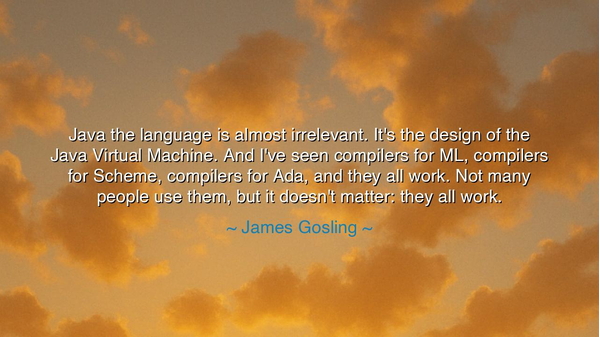
Java the language is almost irrelevant. It's the design of the
Java the language is almost irrelevant. It's the design of the Java Virtual Machine. And I've seen compilers for ML, compilers for Scheme, compilers for Ada, and they all work. Not many people use them, but it doesn't matter: they all work.






“Java the language is almost irrelevant. It's the design of the Java Virtual Machine. And I've seen compilers for ML, compilers for Scheme, compilers for Ada, and they all work. Not many people use them, but it doesn't matter: they all work.” So spoke James Gosling, the architect of Java, and in his words lies a truth as profound as the foundations of any great civilization. He reminds us that what endures is not the ornament, but the architecture beneath it—not the passing language of the moment, but the eternal design that gives it form and purpose.
In these words, Gosling reveals the secret wisdom of builders, both ancient and modern. The Java language, elegant and useful though it may be, is but a vessel. Its true power lies in the invisible engine beneath—the Java Virtual Machine (JVM)—a creation so profound that it transcends the language it was born to serve. It is a world within a world, a sanctuary where countless tongues may speak and be understood. The JVM is not merely code; it is design immortalized, a foundation upon which many civilizations of software may rise.
So it has been since the dawn of creation. When the Romans raised their aqueducts and roads, it was not the language of their builders that mattered, but the design principles they followed—balance, durability, harmony. Centuries have passed, empires have fallen, but still their structures stand, because the underlying design was timeless. So too, Gosling’s words teach us that languages come and go—C fades, Python rises, others are born and die—but the architecture that endures beneath them carries forward their spirit, allowing progress to continue long after their names are forgotten.
There is in this teaching a quiet humility, rare among creators. Gosling, the father of Java, calls his own language “almost irrelevant.” This is not self-denial—it is wisdom. He sees what few dare to see: that greatness lies not in what is visible, but in the structures that empower others. The architect builds not for his own glory, but so that others may create within the world he has made possible. The wise engineer, the thoughtful artist, the true leader—all understand this truth. Form is fleeting; foundation is forever.
Consider the story of Dennis Ritchie, who created C, and with it the UNIX operating system—a design so elegant that nearly every modern system still bears its imprint. Like Gosling, Ritchie did not merely make a tool; he made a framework of thought, a design that would outlive its syntax. His work became the invisible backbone of the digital age, unseen yet indispensable. Such is the mark of true creation—not the thing itself, but the continuity of its influence.
From Gosling’s words we may draw a great and practical lesson: do not worship the surface. Whether you are a programmer, an artist, a teacher, or a thinker, seek the principles beneath the practice. Do not cling to trends, for they fade like morning mist. Instead, cultivate understanding, structure, and purpose—these are the engines of all enduring creation. Ask yourself not, “What language shall I speak?” but “What design shall I build that others may use?”
And so, let every creator remember: tools may change, fashions may pass, but the design that serves humanity endures. Build your life as Gosling built the JVM—not as a monument to yourself, but as a framework that empowers others. Let your thoughts be compatible across generations, your wisdom portable across minds.
For in the end, languages will die as leaves in autumn—but the design, the eternal structure of truth and function, shall remain, echoing through time like the unseen heartbeat of all creation.






AAdministratorAdministrator
Welcome, honored guests. Please leave a comment, we will respond soon